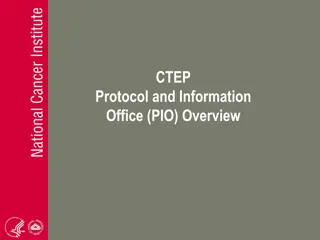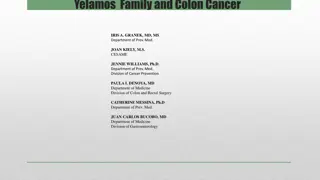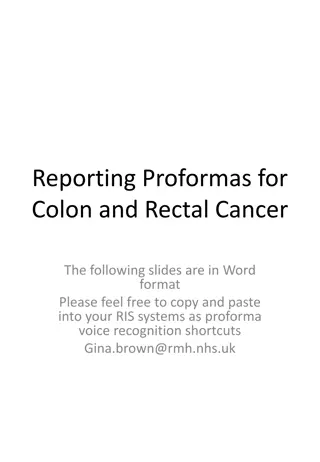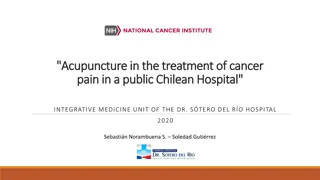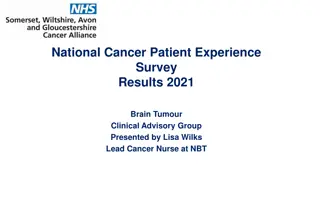
Colon Cancer Treatment: Prognosis, Factors, and Treatment Options
Explore in-depth information on colon cancer treatment including prognosis, residual tumor grades, lymph node examination, microsatellite instability, allelic loss, factors affecting treatment decisions, and various treatment options available for different stages. Stay informed about important considerations in managing colon cancer effectively.
Download Presentation

Please find below an Image/Link to download the presentation.
The content on the website is provided AS IS for your information and personal use only. It may not be sold, licensed, or shared on other websites without obtaining consent from the author. If you encounter any issues during the download, it is possible that the publisher has removed the file from their server.
You are allowed to download the files provided on this website for personal or commercial use, subject to the condition that they are used lawfully. All files are the property of their respective owners.
The content on the website is provided AS IS for your information and personal use only. It may not be sold, licensed, or shared on other websites without obtaining consent from the author.
E N D
Presentation Transcript
Dr babakNejati COLON CANCER TREATMENT
prognosis Residual Tumor (R Stage) at Margins HistologicGradegrade 1 (well differentiated), grade II (moderately differentiated), grade III (poorly differentiated), and grade 4 (undifferentiated). Total Number of Lymph Nodes12 to 15 lymph nodes should be examined in order to determine node negativity Microscopic Nodal MetastasesIHCstaining for cytokeratinAE1/AE3
Sentinel Node Analysis Blood or Lymphatic Vessel Invasion HistologicTypeSignetring carcinomas are characterized by more than 50% of cells Small cell (extrapulmonary oat cell) high-grade neuroendocrine tumors - Medullary carcinoma absence of glands, infiltrated with lymphocytes
Microsatellite Instability MSI-H tumors are more frequently right- sided, high-grade, and mucinoustype increased peritumorallymphocytic infiltration, and are characteristically diploid better long-term prognosis than stage- matched patients with cancers exhibiting MSS. In the patients with MSI-L or MSS tumors, chemotherapy resulted in improved survival
Allelic Loss of 18Q Loss of DCC could impair apoptosis and resistance to chemotherapy Host Lymphoid Response Tumor Borderirregular, infiltrating pattern at the tumor edge CEA level preoperative CEA level above 5 Obstruction and Perforation Diabetes Mellitus
Category III Factors Perineural Invasion Tumor Size and Configuration Hemorrhage or Rectal Bleeding Primary Tumor Location Body Mass Index Blood Transfusions Oncogenesand Molecular Markers Genetic Polymorphisms
Treatment of Stage II Patients obstruction or perforation elevated preoperative CEA poorly differentiated histology high S-phase fraction tumors not demonstrating high levels of microsatellite instability tumors with an 18q deletion
Treatment Options for Stage III FOLFOXschedule is now the most widely used 11% diarrhea , Peripheral sensory neuropathy FLOX may carry a higher risk of serious diarrhea than FOLFOX. Oral capecitabine or oral UFT/leucovorin are acceptable alternatives . irinotecan should not be used in the adjuvant setting
intraportal adjuvant chemotherapy 4% improvement in 5-year overall survival . IntraperitonealChemotherapyhigh first-pass hepatic clearances of 5-FU make these, good agents for intraperitonealadministration. Edrecolomabmonoclonal IgG2a antibody directed against the cell surface glycoprotein Immunotherapy, Vaccine-mediated enhancement of p53-specific T-cell immunity
Radiation Therapy The most common site of failure after surgery in colon cancer is abdominal rather than local. local failures in colon cancer are extrapelvic. retroperitoneal regionssuch as the ascending colon,splenic flexures, and descending colon. the risk of local recurrence is so high because of known or extremely high risk of microscopic or gross residual disease.
positive resectionmargins orT4, adherent to structures or tissues,which cannot resected. cecal tumors invading abdominal wall ,hepatic flexure tumors with duodenal invasion, sigmoid cancers with invasion into pelvic. regional adenopathy that cannot excised, regionally recurrent disease in the para- aortic. Whole abdominal radiation to cure diffuse intra-abdominal and liver disease
Follow-Up CEA tests be performed every 3 months. CEA level is elevated, imaging be performed . physical examination every 3 to 6 months for the first 3 years following resection . OBT, CBC,LFTandCXRwere not thought to be of benefit in postoperative surveillance. annual CT of the chest and abdomen for 3 years colonoscopy at 3 years to detect new cancers and polyps and then every 5 years
Metastasis favorable performance status, acceptable bone marrow, renal, and hepatic function, reasonable nutritional intake. PET scanning other sites of metastatic disease are adequately ruled out. metastases confined to the liver in a resectabledistribution, should undergo resection of both the metastatic and primary tumors.
systemic chemotherapy>>reasse>>favorable response to visible metastases( eradication micrometastases )>> cure from aggressive surgical intervention. Patients who progress to the point of unresectability while taking chemotherapy are not likely benefited from initial resection. notargueto routine noncurative resection for a majority of patients with metastatic disease
continue chemotherapy until there is either unacceptable toxicity, clinical deterioration, or disease progression. discontinuation of therapy after a fixed period of time may be a reasonable . TS, dihydropyrimidine dehydrogenase(DPD), TP,asmeasured in a tumor specimen by RT- PCR, predict for failure to respond to an infusional 5-FU regimen.
Bevacizumab humanized monoclonal antibody that binds to VEGF, thus preventing receptor activation. Hypertension,thromboembolic events and proteinuria CVA, MI, TIA and angina the risk was essentially linear over time, indicating that the risk of a new arterial thrombotic event was the same in earlier. GI perforations perforated gastric ulcer, small bowel perforations.
Cetuximab chimericmonoclonal IgG1antibody that recognizes and binds to the extracellular domain of the EGFR. acnelike rash 75% to 100% of patients treated. Drying agents and retinoids, such as are used in the treatment of acne, are contraindicated. hypomagnesemiaThis results from hypermagnesuria
absolutely no correlation between the intensity of the EGFR expression and clinical response. no patient should be excluded from anti- EGFR therapy simply on the basis of a negative EGFR IHC stain. Panitumumab (ABX-EGF) is a fully humanized monoclonal antibody that also targets the EGFR






